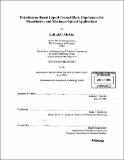Polysiloxane-based liquid crystal block copolymers for piezoelectric and mechano-optical applications
Author(s)
McAfee, LaRuth C. (LaRuth CaSandra)
DownloadFull printable version (8.090Mb)
Other Contributors
Massachusetts Institute of Technology. Dept. of Chemical Engineering.
Advisor
Paula T. Hammond.
Terms of use
Metadata
Show full item recordAbstract
Liquid crystal research has gained interest in a wide range of applications that go beyond displays. Some of these applications include memory devices, sensors, and variable light valves. Currently, liquid crystals in the form of small molecules are capable of exhibiting fast response times; however, there are many advantages to using block copolymers in these applications, such as the surface stabilization caused by the block copolymer morphology, and recent research has increased in the area of LC block copolymers. In this group, LC block copolymer research has focused on diblock copolymers with one amorphous block and one side-chain LC block, and examined fundamental phase behavior of these complex systems, and the interplay between liquid crystal and block copolymer ordering. This research seeks to examine the potential use of ferroelectric and nematic LC block copolymer elastomers as actuators. These devices can be used as artificial muscles, in microrobotics, in micromachinery, in MEMS, and in other applications that require gates or valves. Artificial muscles have previously been prepared using multilayer composites of conducting polymers and non-conducting materials that may or may not be polymers. Similar functionality could also be accomplished by preparing an amorphous-LC block copolymer with cylindrical morphology. The proposed polymers for this research offer unique processing, mechanical, and electrical advantages over the current technologies because they are both block copolymers and elastomers. (cont.) The main issues that need to be examined when designing such a material are the response time after an electrical pulse has been applied, the amount of strain achievable, and, if used in biological applications, the biocompatibility of the materials. This project specifically studies the first two issues. In order to do this, block copolymers with side-chain liquid crystal mesogens have been synthesized and their properties are currently being studied. Initially, a polystyrene-b-polyvinylmethylsiloxane diblock copolymer backbone with side-chain LC mesogens was studied. Diblock studies are useful as model systems and have potential for electro-optic applications. However, studies on PS-b-PVMS-b-PS triblock copolymers allow us to make a true elastomer. The mesogens were chosen such that the nematic or smectic C* phase will be present at the desired operating temperature and electromechanical actuation can be obtained. Mesogens were attached to homopolymer and BCP backbones. DSC indicated that there was phase mixing in all BCP samples because the PS ... is lowered or absent upon attachment of the mesogen. Nematic mesogens with long alkyl spacers exhibited significant phase mixing and no PS ... unless the polymer backbone was initially more than 50wt% PS. SAXS data showed strong smectic LC order (...), but weak (...) or no BCP order in films at room temperature. TEM and AFM indicated poorly ordered segregated morphologies in samples, which agreed well with the SAXS data. Mesogens with short spacers strengthened BCP phase segregation, as indicated by well-defined block copolymer peaks in SAXS and well-defined interfaces in TEM images. (cont.) At room temperature, some samples did not exhibit liquid crystalline textures or birefringence until sheared or stretched when viewed in the polarized optical microscope, indicating mechano-optical properties. Initial attempts to orient the liquid crystal mesogens have been successful using mechanical stretching in the DMA. Also, a new setup has been developed and preliminary studies have begun to measure the electromechanical properties of these materials.
Description
Thesis (Ph. D.)--Massachusetts Institute of Technology, Dept. of Chemical Engineering, 2005. Includes bibliographical references.
Date issued
2005Department
Massachusetts Institute of Technology. Department of Chemical EngineeringPublisher
Massachusetts Institute of Technology
Keywords
Chemical Engineering.